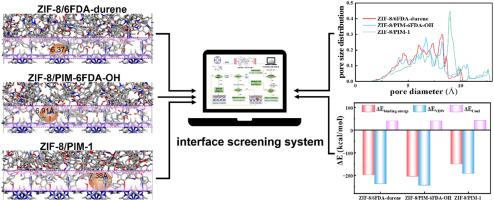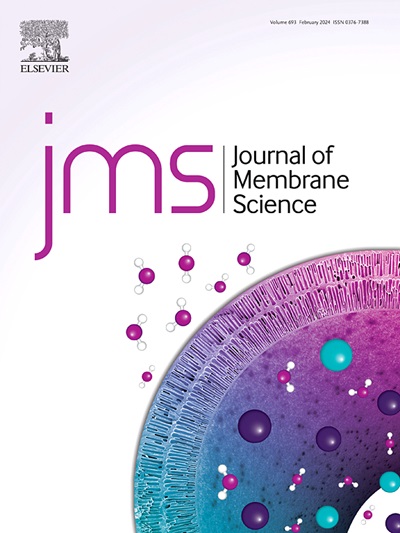Toward quantitative evaluations of interfacial compatibility of ZIF-8 based mixed-matrix membranes via molecular simulations
IF 8.4
1区 工程技术
Q1 ENGINEERING, CHEMICAL
引用次数: 0
Abstract
ZIF-8-based Mixed-Matrix Membranes (MMMs) have demonstrated promising potential for propylene/propane separation, but improvements in gas separation efficiency are hindered by the interfacial compatibility between ZIF-8 and the polymer matrix. In this study, we employed molecular modeling and simulations to construct and quantitatively compare the microstructural and energetic properties of three MMMs, including ZIF-8 with PIM-1, 6FDA-durene, and PIM-6FDA-OH. We assessed the applicability of the General Amber Force Field for modeling these MMMs and confirmed its validity. A protocol was developed to accurately define the interface region of the MMMs, ensuring reliability in calculating interfacial properties. Using this defined interface, we evaluated and compared the atomic concentration profile, interfacial length, polymer porosity, pore size distribution, and interfacial binding energy. Our findings indicate an order of interfacial compatibility as follows: ZIF-8/PIM-6FDA-OH > ZIF-8/6FDA-durene > ZIF-8/PIM-1, aligning well with literature reports. Further molecular-level analysis through radial distribution functions and dihedral angle distributions supported this compatibility order. Additionally, we explored the impact of modeling size on characterizing interfacial properties, affirming that our model effectively balances simulation accuracy and efficiency. Propylene/propane adsorption properties were also computed, revealing potential mechanisms for enhanced gas solubility in different MMMs. Most importantly, this comprehensive investigation led to the development and validation of an interface screening system, providing a reliable and efficient method for designing or screening polymer-filler pairs to improve gas separation performance.

通过分子模拟定量评估基于 ZIF-8 的混合基质膜的界面相容性
基于 ZIF-8 的混合基质膜 (MMM) 在丙烯/丙烷分离方面表现出了巨大的潜力,但 ZIF-8 与聚合物基质之间的界面相容性阻碍了气体分离效率的提高。在本研究中,我们利用分子建模和模拟构建了三种 MMM,并定量比较了它们的微观结构和能量特性,其中包括带有 PIM-1、6FDA-杜烯和 PIM-6FDA-OH 的 ZIF-8。我们评估了通用琥珀力场对这些 MMM 建模的适用性,并确认了其有效性。我们制定了一项协议,以准确定义 MMM 的界面区域,确保计算界面特性的可靠性。利用这种定义的界面,我们对原子浓度分布、界面长度、聚合物孔隙率、孔径分布和界面结合能进行了评估和比较。我们的研究结果表明,界面相容性的顺序如下:ZIF-8/PIM-6FDA-OH>;ZIF-8/6FDA-durene>;ZIF-8/PIM-1,与文献报道完全一致。通过径向分布函数和二面角分布进行的进一步分子水平分析也支持这种相容性顺序。此外,我们还探讨了建模尺寸对界面特性表征的影响,结果表明我们的模型有效地平衡了模拟精度和效率。我们还计算了丙烯/丙烷的吸附特性,揭示了不同 MMM 中气体溶解度增强的潜在机制。最重要的是,这项综合研究开发并验证了界面筛选系统,为设计或筛选聚合物-填料对以提高气体分离性能提供了可靠而高效的方法。
本文章由计算机程序翻译,如有差异,请以英文原文为准。
求助全文
约1分钟内获得全文
求助全文
来源期刊

Journal of Membrane Science
工程技术-高分子科学
CiteScore
17.10
自引率
17.90%
发文量
1031
审稿时长
2.5 months
期刊介绍:
The Journal of Membrane Science is a publication that focuses on membrane systems and is aimed at academic and industrial chemists, chemical engineers, materials scientists, and membranologists. It publishes original research and reviews on various aspects of membrane transport, membrane formation/structure, fouling, module/process design, and processes/applications. The journal primarily focuses on the structure, function, and performance of non-biological membranes but also includes papers that relate to biological membranes. The Journal of Membrane Science publishes Full Text Papers, State-of-the-Art Reviews, Letters to the Editor, and Perspectives.
 求助内容:
求助内容: 应助结果提醒方式:
应助结果提醒方式:


